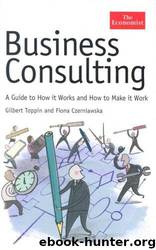Business Consulting: A Guide to How It Works and How to Make It Work (Economist Series) by Gilbert Toppin & Fiona Czerniawska

Author:Gilbert Toppin & Fiona Czerniawska [Toppin, Gilbert & Czerniawska, Fiona]
Language: eng
Format: epub
ISBN: 9781861977021
Publisher: Bloomberg Press
Published: 2011-01-07T05:00:00+00:00
BUSINESS CONSULTING
The law of the few
Media criticism of the consulting industry is unlikely to drive change unless there is a clear agenda for change and a coherent voice in the form of a pressure group or a small number of influential evangelists.
To what extent is a coherent agenda emerging among clients? Clients are remarkably consistent about the kinds of changes they would like to see in the consulting industry:
Information. It often looks as though consultants are only too keen to regurgitate the latest solution or package without trying to take into account a client’s specific situation. This means that there may be lots of impressive presentations but little substance.
It is not just the consulting firms that are at fault; clients should demand better information.
A code of practice. This would correct the distortion many clients see, particularly during a recessionary period, in which consultancies, under pressure to maintain the growth rates of the previous decade, are tempted to sell clients work they do not need and cannot afford. In other words, clients need reassurance that consultants are genuinely acting in their interests.
Accountability. Many clients feel that consultants should have a similar level of professional liability as, say, lawyers and accountants for their advice. The underlying concern is clarity of ownership. The majority of clients accept that there are consulting projects where the buck unequivocally stops with them. They also believe that there are other projects where responsibility can reasonably and unambiguously be assigned to the consultants involved. Their main concern, therefore, is when accountability is unclear, when they think consultants are ducking the issues.
The consulting industry has begun to respond to this agenda. Trade associations like the Management Consultancies Association have codes of practice which their members must abide by. Contractual structures, which share the risks and rewards of projects between clients and consultants, are becoming more prevalent. However, the problems in exchanging information and the intangible nature of consulting services constitute formidable barriers to making the industry more transparent.
These barriers are also part of the reason there has been no collective pressure from clients for change. Many of the companies surveyed for 132
Download
This site does not store any files on its server. We only index and link to content provided by other sites. Please contact the content providers to delete copyright contents if any and email us, we'll remove relevant links or contents immediately.
| Consulting | Entrepreneurship |
| Franchises | Home Based |
| Marketing | New Business Enterprises |
| Nonprofit Organizations & Charities |
Pioneering Portfolio Management by David F. Swensen(6226)
Man-made Catastrophes and Risk Information Concealment by Dmitry Chernov & Didier Sornette(5921)
Zero to One by Peter Thiel(5686)
The Motivation Myth by Jeff Haden(5156)
The Miracle Morning by Hal Elrod(4637)
Elon Musk by Ashlee Vance(4032)
The Art of Persistence: Stop Quitting, Ignore Shiny Objects and Climb Your Way to Success by Michal Stawicki(3624)
Unlabel: Selling You Without Selling Out by Marc Ecko(3590)
Delivering Happiness by Tony Hsieh(3369)
Urban Outlaw by Magnus Walker(3342)
Purple Cow by Seth Godin(3141)
Mastering Bitcoin: Programming the Open Blockchain by Andreas M. Antonopoulos(2981)
The Marketing Plan Handbook: Develop Big-Picture Marketing Plans for Pennies on the Dollar by Robert W. Bly(2976)
The Power of Broke by Daymond John(2898)
The Content Trap by Bharat Anand(2863)
Applied Empathy by Michael Ventura(2839)
The Airbnb Story by Leigh Gallagher(2799)
Keep Going by Austin Kleon(2696)
Radical Candor by Kim Scott(2670)
